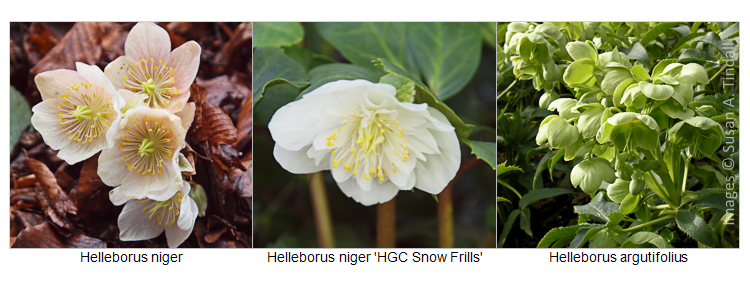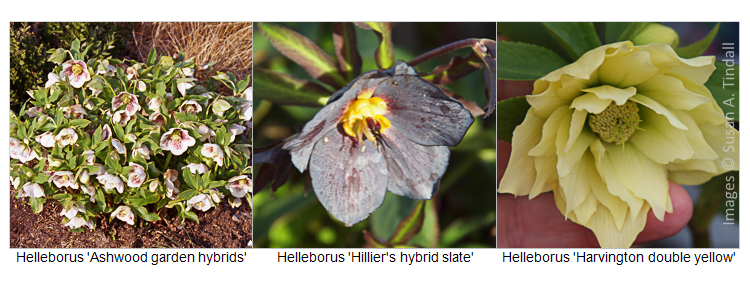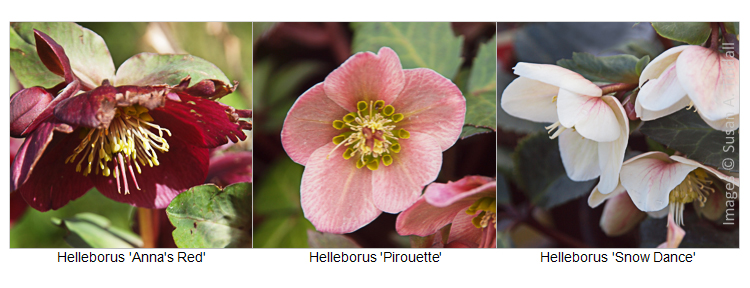18 November 2015
Hellebores - the Christmas rose
 Helleborus niger the Christmas rose, has always been one of the earliest forms to flower, often, as the name suggests, around Christmas. In recent years showier forms have been introduced with marbled foliage and flowers that turn pink with age, an example being Helleborus niger HGC Snow Frills = 'Coseh 230'. The robust Helleborus argutifolius with its pale green scented flowers, is an old favourite and good for lightening shady spots. Its easy-going habit may not appeal to those who like rigidly disciplined plants.
Helleborus niger the Christmas rose, has always been one of the earliest forms to flower, often, as the name suggests, around Christmas. In recent years showier forms have been introduced with marbled foliage and flowers that turn pink with age, an example being Helleborus niger HGC Snow Frills = 'Coseh 230'. The robust Helleborus argutifolius with its pale green scented flowers, is an old favourite and good for lightening shady spots. Its easy-going habit may not appeal to those who like rigidly disciplined plants.  The Helleborus x hybridus forms look particularly good planted in the garden. There are both single and double-flowered forms in shades of black, purple, maroon, red, white, cream and yellow. Many of them hang their heads so, in the manner of snowdrops, you need to lift the flower gently upwards with a finger in order to reveal the beauty within. Those with light-coloured flowers, for example Helleborus x hybridus Ashwood Garden hybrids - cream-spotted are visible at a distance and can be positioned so they can be enjoyed from a window. The dark-flowered forms, like the dark beauty Helleborus x hybridus 'Hillier's hybrid slate', have an alluring mystery, so mysterious that they can completely disappear from view if incorrectly placed, so put these in the foreground. Elegant single-flowered forms, Helleborus x hybridus 'Harvington double yellow' for instance, can be combined with the many-petalled doubles. Hellebores can be planted in small well-spaced groups or dotted amongst spring bulbs, pulmonaria, epimedium and primroses. Plan for their summer foliage effect when spacing plants as hellebores can become substantial. The hellebore x hybridus varieties have large whorled leaflets and, as they mature, make a mound of dark green foliage that makes a quiet interlude when not in flower. They can usefully be planted in front of taller deciduous shrubs that will be a highlight in your garden at other seasons. They thrive in part or light shade and can be planted on the ‘shady side’ of large plants, provided there is an access path that can be used to view them. During winter, when, or before the plant flowers, the old leaves are best cut to the ground so the flowers are visible, the young foliage swiftly re-grows.
The Helleborus x hybridus forms look particularly good planted in the garden. There are both single and double-flowered forms in shades of black, purple, maroon, red, white, cream and yellow. Many of them hang their heads so, in the manner of snowdrops, you need to lift the flower gently upwards with a finger in order to reveal the beauty within. Those with light-coloured flowers, for example Helleborus x hybridus Ashwood Garden hybrids - cream-spotted are visible at a distance and can be positioned so they can be enjoyed from a window. The dark-flowered forms, like the dark beauty Helleborus x hybridus 'Hillier's hybrid slate', have an alluring mystery, so mysterious that they can completely disappear from view if incorrectly placed, so put these in the foreground. Elegant single-flowered forms, Helleborus x hybridus 'Harvington double yellow' for instance, can be combined with the many-petalled doubles. Hellebores can be planted in small well-spaced groups or dotted amongst spring bulbs, pulmonaria, epimedium and primroses. Plan for their summer foliage effect when spacing plants as hellebores can become substantial. The hellebore x hybridus varieties have large whorled leaflets and, as they mature, make a mound of dark green foliage that makes a quiet interlude when not in flower. They can usefully be planted in front of taller deciduous shrubs that will be a highlight in your garden at other seasons. They thrive in part or light shade and can be planted on the ‘shady side’ of large plants, provided there is an access path that can be used to view them. During winter, when, or before the plant flowers, the old leaves are best cut to the ground so the flowers are visible, the young foliage swiftly re-grows.  Luscious hybrids have been developed to maximise foliage, as well as floral appeal. These are both expensive and irresistible. They merit extra care, with soil that is always moist, a sheltered, partly shaded position and some space. They can work well as ‘spot plants’ in the garden, or often succeed best as specimens in large containers. Helleborus (Rodney Davey Marbled Group) ‘Anna’s Red' with pink and green marbled foliage, Helleborus x ericsmithii 'Pirouette' with jagged silvered foliage, and dusky pink Helleborus x ballardiae Snow Dance = 'Coseh 800' among many others, are good examples of these aristocrats. Enjoy! This blog post was kindly contributed by Susan A. Tindall
Luscious hybrids have been developed to maximise foliage, as well as floral appeal. These are both expensive and irresistible. They merit extra care, with soil that is always moist, a sheltered, partly shaded position and some space. They can work well as ‘spot plants’ in the garden, or often succeed best as specimens in large containers. Helleborus (Rodney Davey Marbled Group) ‘Anna’s Red' with pink and green marbled foliage, Helleborus x ericsmithii 'Pirouette' with jagged silvered foliage, and dusky pink Helleborus x ballardiae Snow Dance = 'Coseh 800' among many others, are good examples of these aristocrats. Enjoy! This blog post was kindly contributed by Susan A. Tindall






